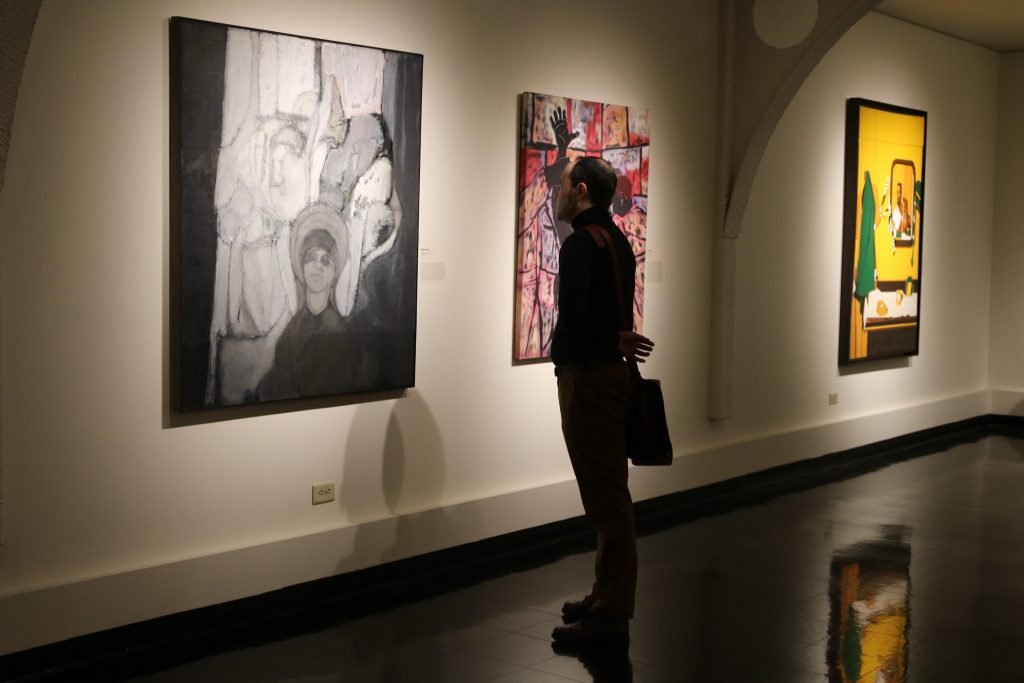The Binghamton University Art Museum’s newest exhibition focuses on the symbiotic relationship between artists and paintmakers.
Hosted this past Thursday, Feb. 1 from 5 p.m. to 7 p.m., the exhibition’s opening reception included a brief chat about the pieces on display and a musical performance inspired by three of the artworks.
“Painted Exchanges: Artists and Paintmakers” features pieces from a distinct period of art history, ranging from 1968 to 1976, when artists began to experiment with different types of paint and forms of expression. The works were donated to the BU Art Museum by paintmaker Leonard Bocour, founder of Bocour Artist Colors, his wife Ruth Bocour and Bocur’s nephew Sam Golden.
The artists represented in the exhibition benefitted from a system of exchange. Paintmakers would give paints to financially struggling artists in order to provide more opportunities, and in return the artists would give feedback on the qualities that painters wanted in their materials. Bocour and Golden made significant contributions to this kinship with artists.
The exhibition is cocurated by Pamela Smart, associate dean at Harpur College and associate professor of art history, and Andrea Kastner, a lecturer of art and design. Donors provided support to the Binghamton Fund and to the Kenneth C. Lindsay Study Room Fund for the University Art Museum.
Smart discussed the inspiration behind this semester’s exhibition.
“I have an interest in artist materials, so I’ve had a history of being in conversation with Golden Artist Colors paint manufacturers in New Berlin, New York,” Smart said. “Golden Artist Colors was founded by [Golden] who was a partner in Bocour Artist Colors, the preceding company, and when I learned that we had works that had been donated to our museum by [Bocour] I was intrigued and learned that Bocour and [Golden] had donated artworks to many university and civic museums all over the country, so we became really interested.”
A distinguishing feature of this exhibition is the diversity of the works, embodying the experimentation of the time. Smart commented on what makes the display so unique.
“Most art exhibitions are really kind of focusing on a much more unified theme,” Smart said “For us, because these were such disparate works, but linked in them being from a very short period of time, they really gave us a picture of a moment of artmaking in all of its variety.”
Students who were part of the source project, a first-year research project that lets students explore a topic of interest, were also able to contribute to the exhibition by choosing a piece to study. “Thinking Through Painting,” a course taught by Smart and Kastner, allows students to work with and conduct research on the paintings that are currently on display.
Kate Langsdorf, a junior double-majoring in philosophy, politics and law and Asian and Asian American studies, was part of the source project course her freshman year. Langsdorf spoke of her appreciation for the painters featured in the exhibition.
“Every painter in this collection is really unique and interesting, because unlike a usual art exhibit where it’s a collection of very well-known paintings or artists, a lot of these painters didn’t really reach the same level of critical success,” Langsdorf said. “In some senses you get to see a wider representation of art styles, different competing art movements and almost a more unique collection of expression.”
Commencing at 6 p.m., the music performance featured three student composers, Binny Rivkin, an undecided sophomore, Christina Yavdoshnyak, a senior majoring in integrative neuroscience and music and Daniel Baneni, a sophomore double-majoring in philosophy, politics and law and music. The composers were able to choose a painting and put their own meaning behind it through music. The songs ranged from adventurous and upbeat tunes to emotional pieces about current events in the world.
Rivkin commented on what he gained from this experience.
“[I gained] an appreciation for art,” Rivkin said. “I like music, that’s also an art, but painting — it’s not something that I really stare at all the time and think about, but with this painting I did have to stare at it for quite a while and think about it and appreciate it. Even now when I saw it I’m noticing things that I didn’t notice the first time.”
The opening reception brought various forms of expression together, emphasizing the interconnectedness of different types of art. Smart reflected on the meaning behind the exhibition.
“Art doesn’t exist on its own,” Smart said. “It actually needs a whole infrastructure to sustain it. It needs good quality materials. It needs expert conservators. It needs museum institutions. It needs art writers and historians to discuss the works. It needs collectors. The message is, art requires this whole ecosystem to sustain it.”
“Painted Exchanges: Artists and Paintmakers,” will be on display at the BU Art Museum from Feb. 1 to May 11.



